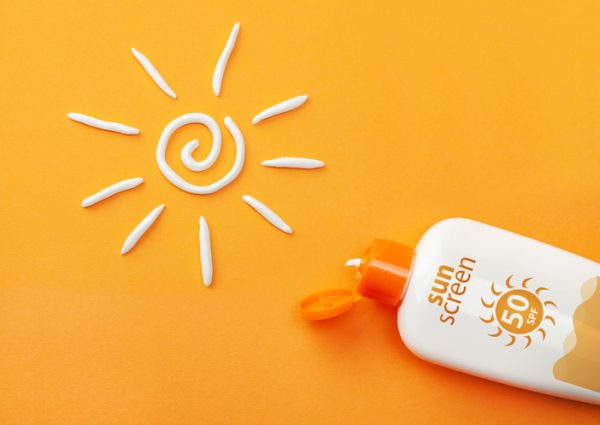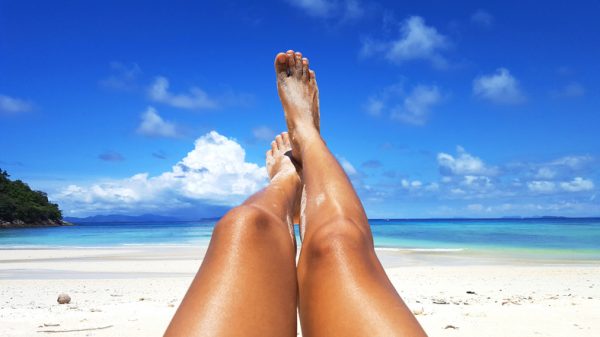By: Cat Ebeling, RN, MSN-PHN, co-author of the best-sellers: The Fat Burning Kitchen, The Top 101 Foods that Fight Aging & The Diabetes Fix
It’s summertime and after a long cold winter, it feels so great to get out in the sunshine. But should we fear the sun? Do we need to slather sunscreen all over us or wear long sleeved shirts and hats?
I find it odd to think that back in the days of our hunter/gatherer ancestors, there was no sunscreen, no hats, no umbrellas—nothing. How did they do it?
We actually need the sunlight on our skin for mental, emotional and health reasons. We must have sunlight. It’s essential to our health and wellbeing.
The Health Benefits of Sunlight
Some of the essential benefits sunlight provides include:
- Immune Health—Sunlight actually helps to stimulate our T cells in the skin. T cells destroy pathogens and are an important part of our immune systems.
- Vitamin D—Is a hormone that helps strengthen and modulate our immune system, regulate our sex hormone production, strengthen bones, teeth, protect our heart health, prevent cancer and keeps our genes healthy. The best way to get vitamin D is from the sun–but not if you block UVB (the rays that can burn) rays.
- Nitric Oxide—Helps our blood vessels stay dilated and increases blood flow. It also reduces blood pressure, improves cardiovascular health, and physical performance. Sun increases nitric oxide.
- Circadian Rhythm—Our sleep-wake cycle depends on our circadian rhythms. We need daylight sun and nighttime dark to have a normal sleep-wake cycle. In the daylight, sun triggers serotonin and exposure to sun in the daytime helps our bodies produce melatonin for sound sleep at night.
- Cognitive Function—Since sunlight increases vitamin D production, it has a positive effect on cognitive function—especially in the elderly. Maybe that’s why older folks retire to the Sunbelt.
- Mood–Exposure to sunlight increases the brain’s release of a hormone called serotonin. Serotonin is associated with feeling happy, calm and focused. Low levels of serotonin are associated with a higher risk of depression, especially “Seasonal Affective Disorder” or SAD.
Unfortunately, we’ve been told over and over again to avoid the sun, that the sunlight is dangerous and we should ‘fear’ it. And yes, you can get too much sun. Your skin can get burned or blistered and you can even develop skin cancer from excessive exposure to the sun. So how then, do we get the above benefits of the sun?
The Truth About Sunscreen
Yes, you are correct, getting sunburned is not usually a good thing. This means damage has occurred in your skin and the resulting redness is an inflammatory reaction. A history of blistering sunburns can actually be a predictor of your chances of skin cancer.
However, lifestyle and diet can definitely protect your skin from getting sunburned and can help lessen the damage, including the redness and discomfort of the sunburn.
The sun has two kinds of rays: UVA and UVB. UVB is actually the type that can burn you. Most sunscreens work to block the UVB rays.
However, blocking the UVB rays and just getting UVA rays (the rays that make your skin browner) won’t give many of the health benefits. Vitamin D is actually synthesized the sun’s ultraviolet B (UVB) rays hitting the cholesterol our skin cells, providing the catalyst for vitamin D synthesis to occur.
The trick with sun benefits is to get shorter exposures and build up time in the sun. So that means getting outside but limiting—not avoiding–your exposure to burning rays.
This also means getting real sun, not the kind you get from a tanning bed, which usually only put out UVA rays.
-
Eat plenty of antioxidants
This is actually the key to avoid bad sunburns, and to reduce damage to your skin. Colorful vegetables and fruit are basically a type of edible sunscreen. A diet high in carotenoids (a type of antioxidant in red and orange vegetables) can actually protect against sun damage. Lycopene, the antioxidant in tomatoes has similar skin-protective properties. Vegetables that are high in vitamin C and E are also protective, as are anthocyanidins, the antioxidants found in blueberries, red or dark grapes and red wine. Eating lots of red, orange and purple stuff will prevent your skin from turning those colors!
Skin protective foods include: Berries, tomatoes, carrots, red bell peppers, kale and other dark green leafy veggies, pastured egg yolks, sockeye salmon, and shrimp
-
Eat more omega 3 fats and avoid inflammatory omega 6 fats
Any processed seed oil such as canola oil, sunflower oil, safflower oil, soybean oil, corn oil, or any other “vegetable oil”, is highly dangerous to your health. Seed oils are pro-skin cancer.
How? The short explanation is this—inside each and every cell in our bodies, we have the mitochondria. This is the energy production center of the cell. The cells’ mitochondria need to have specific types fatty acids to communicate with each other and work properly. These fatty acids signal when a cell is damaged or dysfunctional and the cell is destroyed. Omega 6 seed oils shut off the alarm to destroy the dysfunctional cell, and instead it can grow out of control and becomes cancerous.
The more (healthy) omega 3s you consume, the more protection from the sun you enjoy.
Skin protective fats include: Salmon, cod, other wild caught fish, grass-fed beef, pastured eggs, grass-fed butter.
-
Know your own skin type and get the right amount of sun
The lighter your hair and skin, the less sun you need to get enough vitamin D and the other health benefits the sun provides. However, darker skinned people need more time out in the sun, and if you are dark-skinned and living in the northern hemisphere, you may need to take supplemental vitamin D.
-
Get good sleep and get out in the sun early in the day
Did you know your skin’s ability to handle the sun has to do with your circadian rhythm? The skin’s defense against the sun actually works best the first half of the day. So if you are headed to the beach, do it early, not late in the afternoon, when you skin can handle it better.
Early morning sunlight is rich in UVB rays, which also helps prepare your skin for the UVA tanning rays in the afternoon by enhancing its UV resistance.
Daily sun vs sun ‘binging’
People who get out in the sun on a regular basis actually have better defense against skin damage than people who only get intermittent sun exposure. Holiday vacationers who binge on the sun for the week or two they are on vacation are far more likely to be at risk for sun damage, skin cancer and melanomas.
A daily low to moderate dose of the sun is much healthier than occasional sun binging.
What about sunscreen?
Granted, there are times when we all need sunscreen, even if we follow the above guidelines. Camping, a raft trip, boating, fishing, hiking—you name it, if you are outside for long periods of time, sun protection is probably important.
The problem with sunscreens is that the majority of them use chemicals to filter out the sun (mostly UVB) and unfortunately, those chemicals are quickly absorbed into the skin and into the bloodstream where they can be pretty toxic. Some of the more toxic ingredients include:
- Benzophene–Many sunscreens with chemical sun block also come with endocrine disruption. Some forms of the chemical benzophenone will inhibit the action of your thyroid hormones. Result, thyroid hormones T3 and T4 are lower than normal for several days after applying sunscreen with benzophene.
- Octyl-methoxycinnamate–Another common ingredient, octyl-methoxycinnamate is considered a xenoestrogen (artificial estrogen) and disrupts normal hormone function in men and women.
- Oxybenzone—This ingredient filters out UV rays, but it is also an artificial estrogen, which blocks testosterone in men, and can cause estrogen-based cancers in women—in addition to throwing female hormones out of whack. Oxybenzone is also dangerous to unborn children, as this study shows. And sunscreen and bug spray don’t mix—when you apply both, you absorb even more of the toxic bug-killing ingredients as well.
- Octinoxate—This chemical is the most widely used UVB-blocking ingredient. Octinoxate produces estrogen-like activity and also affects thyroid function. The scariest thing about this chemical is how easily it is absorbed into the body and the bloodstream. It has been detected in human breastmilk as well.
- Homosalate – This chemical is also another common UVB-blocking chemical that acts as an artificial estrogen in the body. Homosalate also will increase the amount of pesticides we absorb through the skin, if you happen to use buy spray as well.
- Parabens—One more endocrine disrupting/xenoestrogen synthetic preservative found in cosmetics and conventional sunscreens. Parabens can be tricky to find on labels. Look for ingredient names like methylparaben, propylparaben, isoparaben or butylparaben.
What is SAFE?
If you need to find less toxic protection from the sun, look for formulas that list zinc oxide or titanium dioxide as the active ingredients. Both of these sit on top of the skin, and physically block the sun with little to no absorption through the skin or into the bloodstream.
For a complete list of sunscreens to avoid, and safer sunscreens to use check out this article from Dr. Josh Axe.
Bottom line–if you must spend a long amount of time out in the summer sun, eat a skin-healthy diet, and protect your skin with a safe and natural zinc oxide or titanium oxide based sunscreen too. And enjoy the summer sun!
 thenutritionwatchdog.com What's in your food? Discover which "healthy" foods are harming your health and which foods protect your body
thenutritionwatchdog.com What's in your food? Discover which "healthy" foods are harming your health and which foods protect your body 


I have lived in the Metro Phoenix Region now for 41 years from NY state and do not use sunscreen and my dermatologist says I am fine. I used to spend a great deal of time outside before Covid outside with my Grub Hub part time food delivery business, but now work from home full time for Lumen Technologies over 10 years and probably won’t drive again until I retire in 6 years.
Why doesn’t any nutrition person speak about astaxanthin any more for people over 10? It’s my favorite supplement and sunscreen (NOT) and has so many more uses.
I appreciate what you have written, though as a vegetarian since 1973 and vegan the past 3 years, we can live very healthfully without any animal products. Dr. Zane Kime wrote a book, Sunlight, published around 1980 that details aspects of what you have written. My experience is reflective of what you and he have written. While working in the timber industry and for 6 years spending much time in full sun from 2001-2007, I used sunscreen regularly. This led to an in situ melanoma on my cheek and a few other issues on my face, all of which I had surgically removed or frozen. I told the dermatologist (who taught at a large university) that I believed that my issues were exacerbated by sunscreens which he poo-pooed. After I quit using the sunscreens and started watching more closely the foods with the oils that you describe, I can take full sunlight if I prepare with short durations in the sun first and have no problems. Yes, I am a fair-skinned redhead.